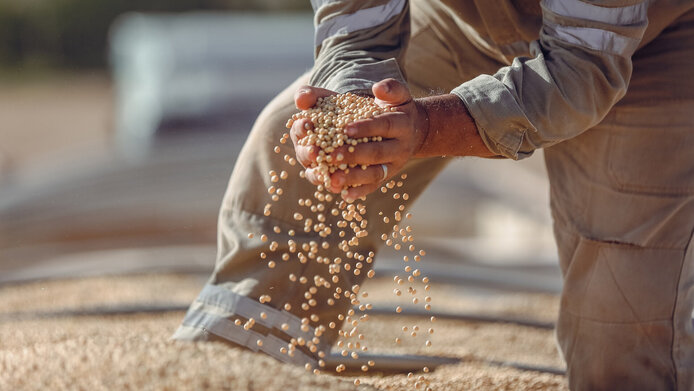The soybean – a witness to globalization

As recently as the 19th century, soy was a niche product that was hardly used beyond the culinary traditions of Japan, Korea and China. But that has changed substantially. The protein-rich legume is now the world's most traded agricultural commodity – by far surpassing wheat, coffee or corn. In the absence of soy serving as animal feed, industrial livestock farming and the enormous amount of meat consumed by humans would hardly be sustainable. This said, the plant is also one of the most important ingredients in a meat-free diet. Its large-scale cultivation shapes the economic systems of entire countries and thus also triggers countless social and ecological problems – from the displacement of indigenous smallholders in Brazil to the loss of biodiversity due to humongous monocultures.
Austria as part of the global soybean network
The rapid rise of the crop is at the core of an FWF-funded research project at the Department of Economic, Social and Environmental History at the Johannes Kepler University Linz. Ernst Langthaler and his team, Maximilian Martsch and Gabriel Tober, are investigating the history of soybeans to find out how the structures of agricultural food supply have changed in the course of globalization. Their focus is on Austria, a country that is a hub of the global soybean network where research into the cultivation of soybeans began very early on. Today, the plant is to be found over a surprisingly large cultivation area.
“Soy is characteristic of the history of globalization and provides a concrete focus for the study of this abstract research subject,” notes Langthaler. “We are examining how Austria is integrated into the global food regime in relation to soy, and we are interested in global interdependencies, commodity flows and their regulation. At the same time, we look at the topic from a grassroots perspective – the perspective of the people or organizations involved in cultivation, trade or processing.” The researchers vetted historical scientific publications and newspaper articles and interviewed experts from various fields, such as breeding, processing and trade. Another source available to them was the estate of the Austrian physician Ernst Kupelwieser, who set up a factory for the production of flour made from soy back in the 1930s.
The project
The soybean is a prime example for the history of globalization. Historians at the University of Linz are researching how this crop rose to prominence so quickly and what role Austria played in this development. Physician Ernst Kupelwieser already built a factory to produce soy-based flour substitutes in the 1930s.
European rise of the soybean starts in Vienna
Soy has a history spanning more than 100 years both worldwide and in Austria. Back in the late 19th century, Friedrich Haberlandt, founder of the University of Natural Resources and Life Sciences, successfully cultivated the first soy plants from seeds he had purchased from Asian traders at the 1873 World's Fair. The attempt to establish soy as a staple food for the population was resumed in the 1930s by the physician Ernst Kupelwieser. He produced flour under the brand name “Edelsoja” in Schwechat.
Soybeans are now grown on a large scale in Austria. In 2023, it covered roughly 87,500 hectares, 35 percent of which used organic farming methods. This makes Austria the seventh-largest soybean producer in Europe. About half of the harvest is used for food production.
The four phases of Austrian soybean history
There are several phases identifiable in the history of soybeans in Austria from 1870 onwards: the first phase was marked by the agronomist Friedrich Haberlandt, a pioneer of soybean cultivation who achieved a global impact. Haberlandt became acquainted with soybeans at the Vienna World Expo in 1873. In his capacity of Professor of Plant Cultivation at the then newly founded University of Natural Resources and Life Sciences in Vienna he conducted numerous cultivation trials. The work of Haberlandt influenced both subsequent generations of scientists and the beginnings of agricultural production in the first half of the 20th century.
As early as the First World War, people were already considering how substitute products made from soybeans could replace cheap animal protein, which became scarce during war years. “Soybeans began to become a key product for crisis resolution,” says Langthaler. This was one characteristic of the second phase, which spanned the two world wars and the Great Depression. The Austrian Ministry of Agriculture continued to conduct soybean trials in the interwar period. A central figure in this context was László Berczeller from Hungary, who developed and patented several soy processing methods based on Haberlandt's work.
Soy as a substitute for animal protein
“One of his patents describes a full-fat soy flour as a cheap and nutritious alternative to expensive meat, an idea which resonated with people at a time of poverty and unemployment,” says Langthaler. At this point, Ernst Kupelwieser comes into play. He set up a factory in Schwechat to commercialize Berczeller's development under the “Edelsoja” brand. “It worked to some extent, but it only became an absolute smash hit after the Anschluss with Nazi Germany,” explains Langthaler. “Edelsoja became part of the canteen food of the labor service and of Wehrmacht rations.” During the war, a London newspaper even dubbed soy the “Nazi bean”. Kupelwieser's industrial plant was ultimately destroyed in an air raid in 1944.
From imports to independent soy production
From the 1930s onwards, soybean cultivation also experienced high growth rates in the USA, where it was seen as a way to improve farmers' incomes and reduce the erosion of farmland. There was also demand for glycerin, produced from fats and oils, for the production of explosives, which led to an extreme increase in the cultivation of oil crops during the war. After 1945, soy was suddenly available in abundance in the USA. Buyers were found in Western Europe, among other places. Austria, where prosperity and meat consumption increased rapidly in the course of post-war recovery, was also among the importing countries. According to Langthaler, this development marked the third phase of domestic soy use in Austria.
The fourth phase began in the 1970s with first attempts to become less dependent on these imports, although this was not appreciated by the US exporters. “An oilseed project in Austria, for example, failed due to US intervention. A US delegation made it quite clear that Austrian exports of milk and cheese to the USA would be jeopardized,” Langthaler notes. In the 1980s, some “soy fanatics” at the Vienna University of Natural Resources and Life Sciences (Boku) started to try growing soy again. Even though cultivation initially declined due to pressure from the USA, Austria’s accession to the EU finally opened up new opportunities for independent soy production.
Tailwind from ban on genetic engineering
In the 1990s, Europe tried to reduce high agricultural surpluses, which led to a first boom for the versatile soybean. A few years later, the debate on genetic engineering began to have an effect. “The demand for GMO-free soy rose sharply and companies began to market their own soy products,” explains Langthaler. “That increase continues to this day. In an international comparison, Austria has a high proportion of soy in agricultural production, with around half of it being used for animal feed and half for human food.” However, the share of imports still considerably outstrips domestic production. Outside Europe, the cultivation of genetically modified soy is now predominant.
Scientific basis for climate-neutral ecology
The global mechanics of a “soy network” have undergone several fundamental shifts over past decades. New interests arising from crises or economic and political situations have repeatedly reshuffled the deck. Today, soybean cultivation is also a major contributor to global warming, given the associated rainforest clearances, the enormous transportation volumes and the fact that it is an essential enabler of factory farming. It has become a relevant ingredient of grievous human intervention in the Earth system, referred to by scientists as the Anthropocene. Future ecologization requires another fundamental change in the food regime. “Our research is a good knowledge base for the discussion on how this transformation can be achieved,” Langthaler sums up. “The European debate on genetic engineering in particular has shown that it is possible to change the rules of the game. This gives us hope that a socio-ecological transformation towards climate neutrality is also possible.”
Personal details
Ernst Langthaler is Professor of Social and Economic History and Head of the Department of Economic, Social and Environmental History at the Johannes Kepler University Linz. Previously, he was a visiting professor at the Universities of Innsbruck and Vienna, a fellow at the Rachel Carson Center for Environment and Society in Munich and head of the Institute for Rural History (IGLR) in St. Pölten. Langthaler's research interests include agricultural and food history as well as global and regional history. Set to run from 2022 to 2026, the project “Soy and Agro-Food Transitions” is awarded EUR 285,000 in funding from the Austrian Science Fund FWF.
Publications
Langthaler E., Martsch M., Tober G.: Agro-Food Change through the Lens of Soy, in: H / Soz / Kult, 14.01.2025 (Tagungsbericht)
Langthaler E.: Soy, in: Jeannie Whayne (Hg.), The Oxford Handbook of Agricultural History (pp. 304–324), Oxford University Press 2024





